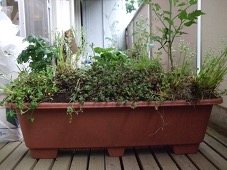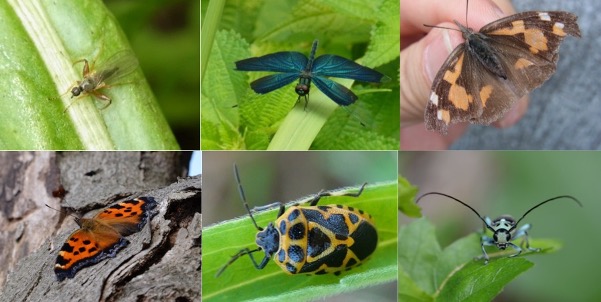Synecoculture Manual
4. Application
4-1. Combining with Rice Cultivation
By conducting Synecoculture in non-plowed, non-fertilized, pesticide-free rice paddies during the dry season, development of the soil can be achieved together with high diversity and high yield of total produce.
4-2. Introduction of Domestic Animals
A wide variety of domesticated animals can be introduced as a part of the fauna that coexists in a Synecoculture farm. As with the vegetation, no artificial feed or chemicals shall be introduced, and that the domesticated animal be treated like a self-supporting wild animal as a part of the ecosystem.
In arid ecosystems in particular, it is known that grassland ecosystems can regenerate through the large-scale movement of livestock and wildlife. Combining this with Synecoculture makes it theoretically possible to construct locally more diverse and productive ecosystems [Funahashi 2025] .
Beekeeping can be carried out even in a small-scale, and has a high synergy rate with Synecoculture. Various vegetables and tree flowers found in Synecoculture farms become source-plants for nectar, and bees contribute to the pollination efficiency and augment nutritional value of the produce. It also increases the value of wildflowers as a nectar source, such as white clover, Chinese milk vetch (Astragalus), and bushkiller (Cayratia japonica). The introduction of beekeeping raises the practical value of wildflowers and blossoming herbs as a part of ecosystem services, and has a significant effect on the vegetation strategy.Though the European honeybee has an established breeding method, they require constant care and may become weak due to the drug-free condition. The introduction of species native to the wild (such as the Japanese honeybee in Japan) is desirable. A Synecoculture home garden and beekeeping set, even privately, can make great contributions to the regional biodiversity.
It is possible to grow birds such as domesticated chickens and pheasants, using the farm’s wild grass and insect population as bait. The leftovers from Synecoculture processed produce can also be used as bait in self-sufficient cycle. It would be necessary to keep them in a small hut to hide them from nighttime predators such as weasels, raccoon dogs, and cats.
It is also possible to raise sheep and goats based primarily on wild grass and herbs for feeding. As an application, they may be used as a part of grass management.
For large livestock such as pigs and cows, as they dig up and tread down the land, they are not suitable for Synecoculture farms producing vegetables. However they may coexist as a byproduct in farms that focus on fruit trees and perennial plants as produce.
For producing with large livestock as a main product, it will be necessary to think in the direction of their natural habitat and behavior: Make entire use of primeval forests and forest edges grassland that can naturally serves plenty of feed, and enclosing it with a fence to create a wild animal ranch. Even with a monotonous tree plantation in mountain range, it is possible to create an environment for livestock by increasing the vegetation that will serve as feed, such as chestnuts and wild yams.
Fish species found in the waterways, rivers, lakes, and ocean waters surrounding the farm should generally also be utilized as produce.
4-3. Cooperation with Hospitals, Nursing Care Facilities
In a case study implemented at a Tokyo care facility, combining visits to and work at the Synecoculture farm with cooking and consuming its produce as part of an integrated rehabilitation program has reported significant cases of improvement in dementia and other immune-related diseases [Funabashi 2022] [Kawaoka et al. 2025] .
4−4. Urban Green Space Design
Synecoculture and the broader concept of augmented ecosystems contribute to supplying and maintaining various ecosystem services in urban areas, including food production, buffering torrential downpours and heat islands, air purification, and creating spaces for recreation and cultural development [Sony CSL] [Funahashi 2025] . Experiments conducted in Tokyo specifically demonstrate that even in locations isolated from the ground, such as rooftop gardens, it is possible to achieve greater plant species diversity and soil microbial diversity than in natural ecosystems [Funabashi 2022] . As of 2025, publicly accessible locations in Tokyo featuring Synecoculture displays include Azabudai Hills and Hibiya Park.
4-5. Using Indigenous Plants
In conventional agriculture, indigenous plants (such as bamboo in Japan) are often considered as weeds and should be eliminated. Though in Synecoculture, we consider that they are establishing an example of suitable ecosystem for that region. Your vegetation plan should be built taking advantage of those characteristics.For example, bamboo and bamboo grass can be found in many abandoned Japanese mountain forests. If left alone it drives away other vegetation with strong root. However a moderate existence rather increases the biodiversity, and the boundary of a bamboo grove can provide various conditions that promote the growth of other vegetation. As produce, there are other possible uses as well, such as tea, material resource, fishing equipment, etc.
4-6. Planter Cultivation
Planter cultivation that adheres to the principles of Synecoculture. Using the topsoil that has already been formed in a natural state, such as from mountain forests, planter cultivation can be performed with no fertilizer and pesticide-free.
Unlike the natural state, as it’s difficult to maintain the homeostasis of the soil environment such as soil temperature in a small scale, it’s not yet possible to achieve a perfect natural circulation with a planter without interfering in the soil over the long term. However it is possible to create vegetables that are close to the ecological optimum state within a certain degree by applying the basic principles.
4-6-1. Planter Cultivation Method
A planter as large as possible should be prepared in order to maintain homeostasis of the soil to the greatest extent possible. Soil with a formed soil structure in a natural state should be introduced, such as that from mountain forests. Plant seeds and seedlings in this soil with a dense mixed state, and let them grow. Naturally originating vegetable organic matter may be placed on the soil, such as the powder of mowed grass.Perform observation to see the effect of different soil quality for mountain soil, bamboo grove soil, perennial plant community soil, grassland soil, etc., whose formation being influenced by each different type of vegetation. Search for the application to planter cultivation according to the soil type.
The Syneco Portal manual is available as an introductory kit at the planter scale, allowing users to experience the scientific principle of the augmented ecosystem underlying Synecoculture [Syneco Portal] .
警告
You must obtain the permission of the landowner before collecting soil. There are many cases where soil collection is prohibited, such as in national parks, preservation area, etc.

4-7. Cooperation with Citizen Science
Currently, as the training for educational institutions, as a conservation research program, and as a part of corporate social responsibility (CSR), a lot of activity is taking place worldwide to document the biodiversity. Synecoculture farm can create and serve as a regional hot spot for biodiversity, and the documentation of the farm can also be used as high-profile data of regional biodiversity. Synecoculture can also be utilized as teaching material for science and environmental education in elementary and junior high schools, with practical examples implemented throughout Japan. Sony CSL provides a web application that integrates information sharing among Synecoculture practitioners with the construction of a biodiversity database [Sony CSL] .
Tip
Within a Synecoculture farm, there are examples of rare insect species being found, including threatened species in IUCN red list.Synecoculture is registered in Sony Group Corporation’s CSR activities and Sustainability Report.

4-8. Large-Scale Mechanization Model
Synecoculture is expected to mechanize and expand its scale in the future in order to efficiently manage vast abandoned farmland, or to increase the productivity in proportion to the smaller number of farmers and the greater level of economic and technological development of the industrialized countries.Provided the fundamental principle and definition of Synecoculture are being observed, mechanization will be allowed only in a case when introduction of machinery and the technology augments the management of a more complex ecosystem.For example, among the management tasks of Synecoculture, planting of seeds and seedlings, grass management, and harvesting are the possible areas for mechanization [Ohtani et al. 2022] [Aotake et al. 2025] .Large-scale Synecoculture farms will require new combinations of vegetation, types and placement of crop, and method of harvesting for efficient management.

